CEDAR BREAKS (Day 18 - part 3)
The museum was absolutely packed full of amazing things! It was hard to know where to begin.

This Green Meenie dates back to 1890. It would have sold for close to $45. It was used for a everyday transportation around town, but since it did not have a brake system, it probably wasn't used in steep areas.

This overland stage was usually pulled by four horses and could seat 7 - 12 passengers (depending on the model). It cost about $600, which was considered cheap since other coaches ran closer to $1,100. Its light weight and durability made it very popular. It had the nickname of "mud wagon" because it was good on extremely muddy routes. This one was used during the late 1800's. There's even a bullet still lodged in its side indicating some exciting moments in its past!

Be it a rifle, pistol or shotgun, firearms were essential in the west at that time for self-defense and/or hunting. The invention of smokeless gunpowder led to the invention of rapid-fire weapons since the shooter no longer had to wait for the smoke to clear before firing again.

There was a great game called What Would You Take? The premise was if you had a wagon that could only carry so much weight, what things would be most important? Naturally things like flour, lard, beans, bacon, salt, tools... but how about a tent (yes, for protection from the elements), or sugar (no, attracts bears and has no nutrition), or whiskey (I would have said yes just to help wash down all those beans and lard!!)?

Glass bottle production began with hand-blown free-form bottles. It was a labor intensive process usually done by young boys. In 1904, the automatic bottle making machine revolutionized the industry. This also resulted in a boom of beer, alcohol, soda and mineral water.

The Clarence was a large family carriage of the upper social class. In the 1860s, it cost around $2,000 (or the equivalent of a Rolls Royce today). It required a coachman and inside the carriage was a bell for signaling the driver.

The Brougham was a gentleman's carriage, originally designed in London around 1840. It was expensive, elegant, and came with a small kerosene lamp, pull up windows, blinds, venters, a cover plate for the steps, and of course a bell for the coachman. It held one or two passengers.


The color of a hearse was important: white was for children; black was for adults. In the late 1600s, they were simply flatbed wagons. But by the mid 1800s, they had become quite sophisticated with glass sides, carvings, lamps and even urns.

Tank wagons were used for transporting oil and water. This one was built around 1894.

The Roof Seat Break originated in England where it was used to break-in horses. Its heavy weight and high driving seats gave the driver greater control over the animals. It eventually turned into a public vehicle for the middle class for it could carry large parties.

Built in 1927, this snowmobile was powered by a two-cylinder motorcycle engine. Cleats attached to a chain belt moved it through the snow.

The Portland or Kimball cutter was developed in the mid 1880s. In 1900, the price ranged from $16.95 to $22.50.The term 'cutter' applies to a one-seat sleigh for two passengers. Anything bigger is just called a sleigh.

Back in the day, milk used to be delivered to your door. Other business used them too such as butchers and bakers. This wagon was used from 1924 to the 1930s. The horses pulling the wagon, Queen and Brownie, became so accustomed to the route that they would wait only so long at each stop before continuing onward... with or without the driver!

What looks like some kind of weapon is actually a glass slide project used in the city's church during WWII.

A model of old Cedar City

Such great detail!

Busses and taxis at the train station

A water tank to fill the steam trains

Loadin' the ol' pickup
It turns out that the museum was just a SMALL section of what there was to see. I made my way outdoors and began exploring, one building after the next.
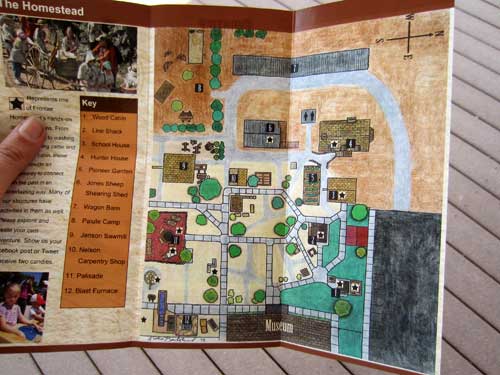
Click for a larger image
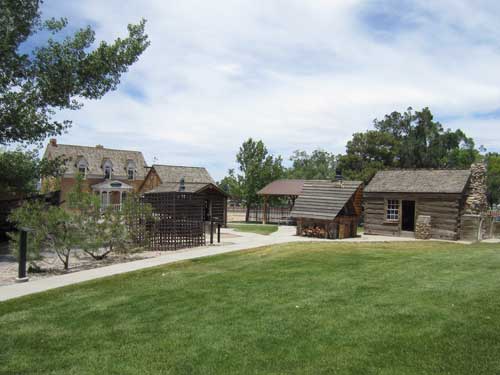
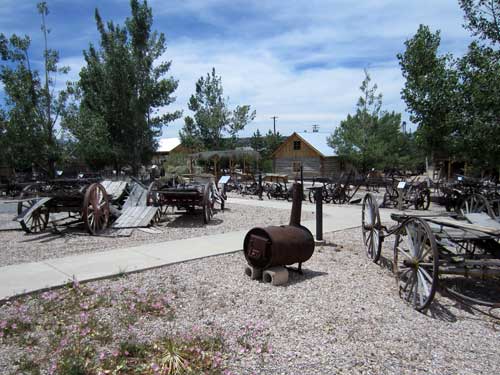

This pioneer cabin is the oldest log cabin in southern Utah. It was built in 1851. Over the many years, it's been the birthplace of 24 children. It was moved here in 1983.


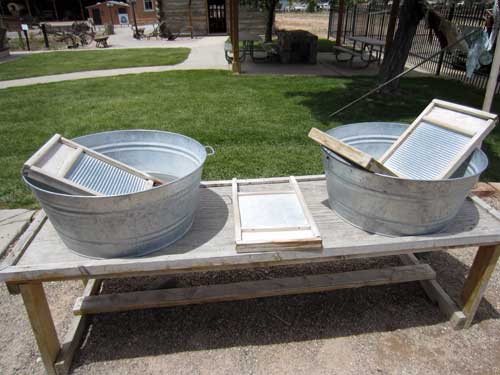
Monday was generally set aside for laundry (it was an all day event) and Tuesday was for ironing. The clothes had to be beaten, boiled, scrubbed on a washboard (such as those pictured above), rinsed, wrung out and hung to dry. Plus all the water had to be collected from nearby streams.

This was the jail to hold offenders until the local sheriff arrived to deal with them... although its last known occupant was a large bear!

Note the super-handy fold-down beds... I assume in case the sheriff took his sweet time getting there!

A telephone line ran between Bryce Canyon and Cedar City. This sparsely furnished Line Shack housed those who maintained the line. It was built in 1945 and donated in 1974.
So how does one build a cabin?? Before you could begin, you first had to find a good location. How close was water (keep in mind that one gallon weighs about 8 pounds)? Were there too many trees (cabins needed to be in a clear area so if they got wet they could dry quickly; wet logs could start to decay)? Was the land level? How would the cabin be oriented to the sun (since cabins were notoriously dark so you wanted to make the most of natural light)?
Then you needed to get the materials. Trees had to be located, felled, peeled and shaped. Logs needed to be straight and of an even thickness (shaped using hand tools). They had to have minimal branches and be cut in winter, when sap content was low. Ideally the would have have to be dried for several months. On the other hand, you also did what you needed to in order to survive.

The exact tools varied but basically you needed at the bare minimum an axe. Various knives, saws and hand spikes (for moving logs) would be nice.
Now it's time to build. You have to clear the area of trees, shrubs and rocks. Maybe you even wanted to first build a stone foundation. The logs needed to be notched in order to be stacked on one another. Ten you needed a bunch of strong, willing friends to help you lift the logs into place. Once the wall was built, you had to fill all the gaps with a chinking material made of whatever you could find... mud, clay, straw, grass, sticks, sand, even animal dung.

Ok, walls are up. But how about windows, door and a fireplace? Mot pioneers didn't have glass so they used greased paper, animal skins or shutters. During the winter, a fur or quilt might have been added. Fireplaces were built of sacked stones cemented together.

And of course you still aren't quite done for there's that small issue of a roof. They could be flat, sloped or peaked. On top of a wood frame, one could use shingles, sod or even just packed dirt.

If there weren't a lot of trees available (which there often aren't in parts of Utah) then other options such as adobe brick houses or sod homes were used. Adobe bricks took a long time to make (mixing clay, water and sand or straw; shaping a brick then letting it dry in the sun). Sod houses were basically big rectangular chunks of earth cut from the ground and stacked on one another.
What was pioneer life like?
Well, we've already learned about doing the laundry. Then there was sweeping the floor (a bit more difficult if you had only a dirt floor). For cooking and baking, the stove (if you were lucky enough to have one - otherwise you had to build a fire in the fireplace which could often get a bit smoky) needed to be heated for at least an hour and required constant attendance. Don't forget you most likely needed to chop all that wood as fuel first. Of course you could also use corn husks, hay, grasses and of course, the ever reliable animal dung.

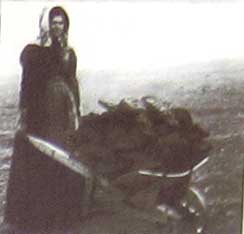
And what would you cook? You had to obtain that first too... edible plants (hope you know which ones those are) and hunting wild game. Perhaps you could even grow a small garden.
After you were done eating, then came time to do the dishes. You had to haul the water and heat it (maybe). Not that you probably could afford to have a lot of dishes and cookware (also since as we already learned, the weight of the things you could put in your wagon was limited). But cleaning up after dinner isn't done yet. There's still all that ash in the stove that needs to be cleaned out regularly.
Whew! But lets not forget the other tasks of maintaining your clothing and bedding... sewing, mending, knitting, weaving, etc.

The most common kind of lamp was just a twisted rag placed in a shallow bowl that had been filled with oil made from plants, animals or camphene (a mixture of alcohol and turpentine). Candles were mostly made from tallow (animal fat) since beeswax was more expensive. When kerosene was discovered in the 1850s, it became highly popular as a fuel source.

The schoolhouse often was the first community building constructed. The local families would then all pitch in and hire a teacher, mostly with room and board as part of the contract.

With indoor staircases being so narrow, it was often necessary to hoist larger pieces of furniture up via ropes and a pulley through upstairs doors.


You are approximately here... deep in the Utah Territory (it doesn't become a state until 1896)

Not quite the 50 stars we are used to

For many immigrants, English was a new language. In 1854, Brigham Young decided to create a new alphabet (named Deseret Alphabet) that would simplify spelling. It had 38 to 40 characters, each representing a specific sound. It had simple characters and there was no difference between printed and cursive writing. Unfortunately it never caught on.

Lessons 23 and 24 from an 1868 primer.

Today, the dunce cap is the symbol of stupidity and shame. Children who misbehaved or failed their lessons were made to wear it as they stood in the corner. The word 'dunce' comes from Johannes Duns Scotus (1266 - 1308), a Franciscan friar, philosopher, theologian and professor at Oxford, Cambridge and Paris. He was a very brilliant man in his time. His followers were known as Dunsmen or Dunces. Duns believed that wearing conical hats increased learning, that they could funnel knowledge to the crown of the head. Besides, powerful wizards and witches also wore them. There is some truth to it, however, in that studies have shown that dyslexic kids who are able to focus their attention on this area can actually increase their ability to concentrate. The hat became a symbol of knowledge... until Duns' teaching fell drastically out of favor around the 16th century and the hat became identified with ignorance rather than learning.

Ideally, instead of having a teacher being housed by various families, a 'teacherage' was built (a room either in or near the schoolhouse). This one was in the attic.
return • continue

